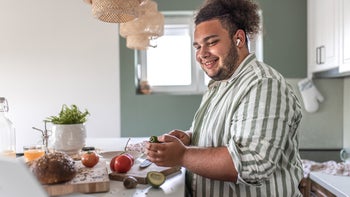
The 11 Best High-Iron Foods to Add to Your Diet
Key takeaways:
Iron is a mineral that your body needs to make red blood cells. A lack of iron can lead to iron-deficiency anemia.
Animal foods that are rich in iron include shellfish, beef, and dark poultry. These contain heme iron, which your body absorbs better than iron from plant-based foods.
Coffee, tea, and phytates from whole grains can lower how much iron your body absorbs. Eating vitamin C-rich foods, such as vegetables and fruits, can help boost iron absorption.
Table of contents
Iron is an essential micronutrient that your body needs every day. The main way your body uses iron is to make red blood cells and hemoglobin, which helps carry oxygen around your body.
But not everyone has enough iron in their diet. In fact, iron deficiency is among the top nutritional deficiencies in the world. The good news is that there are many animal- and plant-based foods that contain high levels of iron. Wondering which foods to eat to make sure you get enough iron? Let’s take a closer look.
Types of iron and foods high in iron
Many animal- and plant-based foods are high in iron. The main difference between the two is the type of iron they provide:
Heme iron: This type of iron is easier for the body to absorb (and use). Heme iron is in meat, fish, and poultry, but it isn’t in any plant-based foods. It makes up about 10% of the iron people get.
Nonheme iron: The body doesn’t absorb this type of iron as well. It’s in vegetables and grains, as well as in iron-fortified foods. Most of the iron people get from their diet comes from these sources.
Discover a simple way to manage diabetes
Patients can use GoodRx to save up to 40% on OneTouch Ultra Strips.

Eating a mix of foods rich in both heme and nonheme iron will help you have better iron absorption overall.
Animal-based foods that are high in iron
Many animal-based foods offer good sources of iron, like chicken and salmon. If you have low iron and eat protein from animal sources, here are four high-iron foods to focus on.
1. Fish and seafood
When it comes to creatures of the sea, there are lots of great choices of iron-rich seafood. Here are some popular fish and seafoods that are high in iron:
Shrimp
Oysters
Tuna
Salmon
2. Red meat
Nearly all types of meat are rich in iron. In general, red meats contain more iron per ounce than other types of meat. Iron-rich types of red meat include:
Beef
Ham
Lamb
Veal
Pork
3. Poultry
Chicken and turkey are a source of iron. Dark meat has more iron than white meat. Choose the thigh or leg instead of the breast if you want the most iron. Poultry options include:
Chicken
Turkey
Duck
Eggs
Are iron supplements right for you? Iron supplements can help fill nutritional gaps if you aren’t getting enough iron in your diet. A reader shares what it feels like to take iron supplements.
Iron deficiency: A lack of iron is one common cause of anemia. Learn more about why this happens.
Signs of low iron: Having low levels of iron can cause dizziness and other symptoms.
4. Organ meats
Organ meats are rich in iron. And you have a handful of options when it comes to high-iron organ meats:
Liver
Kidney
Brain
Heart
Plant-based foods and vegetables high in iron
Plant-based foods contain nonheme iron. This type of iron is more difficult for the body to absorb. But data shows that eating meat and plant-based foods together can increase the iron absorption from both. Here are some plant-based foods to try.
Read more like this
Explore these related articles, suggested for readers like you.
1. Soy foods
Soybeans are legumes, which are naturally rich in iron. The way soy is processed can affect its iron content. For example, soy milk might be fortified with calcium — and calcium limits how well the body absorbs iron.
Soy products that are rich in iron include:
Tofu
Edamame
Soy milk
2. Legumes
Legumes can be a great source of protein in addition to providing your body with iron. Since they contain phytates, soaking or cooking them first can help boost iron absorption. Popular legumes include:
Lentils
Kidney beans
Garbanzo beans
Peas
3. Seeds and nuts
Seeds and nuts are technically legumes too, and they can be useful sources of iron. Common foods in this category include:
Peanuts and peanut butter
Almonds and almond butter
Cashews
Sesame seeds
Chia seeds
4. Leafy greens
Dark leafy greens can be good sources of iron, although many also contain oxalates and other substances that can limit their effect. Try pairing them with vitamin C-containing ingredients to improve iron absorption. Here are a few to try:
Spinach
Kale
Dandelion greens
Collard greens
Chard
5. Vegetables
Many other types of vegetables can be helpful additions to an iron-rich diet. Some, such as tomatoes and onions, also contain vitamin C, which helps boost iron absorption. Popular choices include:
Broccoli
Tomatoes
Green beans
Onions
Asparagus
6. Fruit
Some fruits contain helpful levels of iron, and many also contain vitamin C. Dried fruits tend to have a higher concentration of iron than fresh fruits. Try these iron-rich fruits:
Strawberries
Raisins
Dates
Figs
Dried apricots and peaches
7. Whole grains
Breads and cereals can contain natural nonheme iron, and they’re often fortified or enriched with additional iron as well (check the labels). Look for these iron-containing choices:
Whole-wheat bread
Rye bread
Bran cereal
Corn meal
Enriched bread, cereal, pasta, or rice
How much iron do high-iron foods contain?
Here are 11 foods from the lists above and how much iron they provide.
Food | Serving size | Amount of iron |
|---|---|---|
1. Fortified breakfast cereal | 30 g | 18 mg |
2. Oysters | 3 oz | 8 mg |
3. White beans (canned) | 1 cup | 8 mg |
4. Lentils (boiled) | 1 cup | 6 mg |
5. Spinach (boiled) | 1 cup | 6 mg |
6. Tofu, firm | 1 cup | 6 mg |
7. Beef liver, cooked | 3 oz | 5 mg |
8. Sesame seeds | 1 oz | 4 mg |
9. Tomatoes, cooked | 1 cup | 4 mg |
10. Chicken, roasted (with skin) | 3 oz | 1 mg |
11. Raisins | ¼ cup | 1 mg |
How much iron do you need?
People who follow a vegetarian or vegan diet have higher iron requirements. They need almost twice as much iron as people who eat meat. That’s because their diets contain more nonheme iron, which the body doesn’t absorb as well.
Women also need more iron. The menstrual cycle (period) raises the risk of iron deficiency. And you need even more iron when you're pregnant. If you're nursing, talk with your OBGYN to make sure you're getting the right amount of iron for you and your baby. That’s because the menstrual cycle (period) raises your risk for iron deficiency when you’re pregnant or nursing.
Here are the recommended amounts of iron for different groups of people.
Non-vegetarian diet | Vegetarian or vegan diet | |
|---|---|---|
Men (ages 9 to 51+) | 8-11 mg | About 14-20 mg |
Women (ages 8 to 51+) | 8-18 mg | About 14-32 mg |
Pregnant women | 27 mg | About 48 mg |
Nursing mothers | 9-10 mg | About 16 mg |
Foods that hurt iron levels
Some foods make it harder for your body to absorb iron from your diet. This is especially a problem if you eat the foods together. Iron-lowering foods include:
Tea and coffee: Black tea and coffee contain polyphenols, which interfere with nonheme iron absorption. Plan to enjoy these drinks between meals if you’re trying to improve your iron levels.
Phytates: These are natural compounds in plant-based foods such as beans, seeds, and whole grains. They can block the absorption of certain minerals, such as iron. Soaking and cooking foods can help counteract the effect of phytates on iron absorption.
Calcium: Dairy foods, like milk, cheese, and yogurt may affect both heme and nonheme iron absorption.
Oxalates: These substances are also linked to low nonheme iron absorption. They’re commonly found in leafy greens, as well as beans, seeds, and nuts.
While it’s important to be mindful of these foods and beverages, you don’t need to avoid them altogether. Simple changes to when and how you consume them can help.
How to boost iron absorption
If you’re low in iron, there are some steps you can take to make sure your body is absorbing as much iron as possible. Consider these tips:
Be mindful of your drinks. Instead of drinking tea and coffee with a meal, enjoy these drinks between meals.
Time your supplements. Calcium supplements can get in the way of iron absorption, so take them several hours before you eat an iron-containing meal. And if you’re taking an iron supplement too, it’s best not to take them together.
Add vitamin C. Try pairing iron-rich foods with vitamin C-rich foods, like fruits and vegetables. This can help your body absorb iron better. For example, top iron-fortified cereal with strawberries or add red peppers to bean salad.
Switch to iron cookware. Using iron pots and pans, along with iron utensils, can help increase the iron in your food as you cook. This is especially true for foods containing heme iron (animal-based foods).
In general, following a nutritious diet can raise the likelihood of meeting your nutrient needs, including iron.
Are foods high in iron more effective than iron supplements?
Iron-rich foods and supplements are both effective. Some people are able to get enough iron from their food. But different factors can make it harder for you to maintain a normal iron level without supplements. Things that can affect your risk for being low in iron include your ability to absorb iron and any medical conditions you might have.
When to talk to a doctor about iron supplements
Talk to a healthcare professional about iron supplements if you have symptoms of low iron or iron-deficiency anemia, such as:
Paleness
Tiredness
Hair loss
Fast heartbeat
Poor concentration
Ice cravings
A healthcare professional might also recommend iron supplements if you:
Are pregnant or nursing
Can’t absorb iron well due to conditions like Crohn’s or celiac disease
Have heavy periods
Have cancer
Have heart failure
Donate blood frequently
Frequently asked questions
Red meat, especially organ meat — like liver or kidney — has more iron than any other food. And since meat contains heme iron, your body can readily absorb it.
Most beverages aren’t great sources of iron unless they’ve been fortified. But apple juice, orange juice, and other fruit juices are good sources of vitamin C. And since vitamin C helps your body absorb iron, it can be helpful to drink these with meals. Smoothies and fortified juices often have iron added as well.
Cocoa powder is a good source of iron, but calcium blocks iron absorption, so cocoa-containing beverages that aren’t made with cow’s milk are another option.
Anemia is a medical condition caused by a lack of healthy red blood cells. A diet low in iron can cause anemia, but there are other causes as well. If you’ve been told you have anemia, you’ll want to pay close attention to how much iron you get from your diet. Use the chart above as a guide. You can help keep your red blood cells as healthy as possible by making sure you have all the iron they need.
The fastest way to raise iron in your body is to take an iron supplement or get an iron infusion. To raise your iron level quickly using only what you eat, look for iron-fortified foods and increase the red meat and leafy vegetables in your diet while limiting dairy products. Don’t forget to supplement vitamin C with your meals, too.
Yes. Taking too much iron all at once can cause stomach pain and constipation. And very large doses can be dangerous, especially for children. Over time, high doses of iron supplements can cause iron to build up in the body, a condition known as secondary hemochromatosis.
The bottom line
Iron is a mineral that everyone needs for important body functions. Most people can get enough iron by eating a variety of animal- and plant-based foods. But keep in mind that some foods can lower your iron absorption.
If you’re concerned about your iron intake, talk with your healthcare team. They can recommend dietary changes or supplements to make sure you’re getting enough iron.
Why trust our experts?



References
American Red Cross. (n.d.). Iron rich foods.
Bushway, A. A., et al. (1984). Differences in the pH and iron content of chicken white and dark meat that effect the action of nitrite against aerobes. Canadian Institute of Food Science and Technology Journal.
Consalez, F., et al. (2022). The effect of the meat factor in animal-source foods on micronutrient absorption: A scoping review. Advances in Nutrition.
Ems, T., et al. (2023). Biochemistry, iron absorption. StatPearls.
Office of Dietary Supplements. (2023). Iron.
Piskin, E., et al. (2022). Iron absorption: Factors, limitations, and improvement methods. ACS Omega.
Sharma, S., et al. (2021). Effect of cooking food in iron-containing cookware on increase in blood hemoglobin level and iron content of the food: A systematic review. Nepal Journal of Epidemiology.
World Health Organization. (n.d.). Micronutrients.
Zijp, I. M., et al. (2000). Effect of tea and other dietary factors on iron absorption. Critical Reviews in Food Science and Nutrition.





























